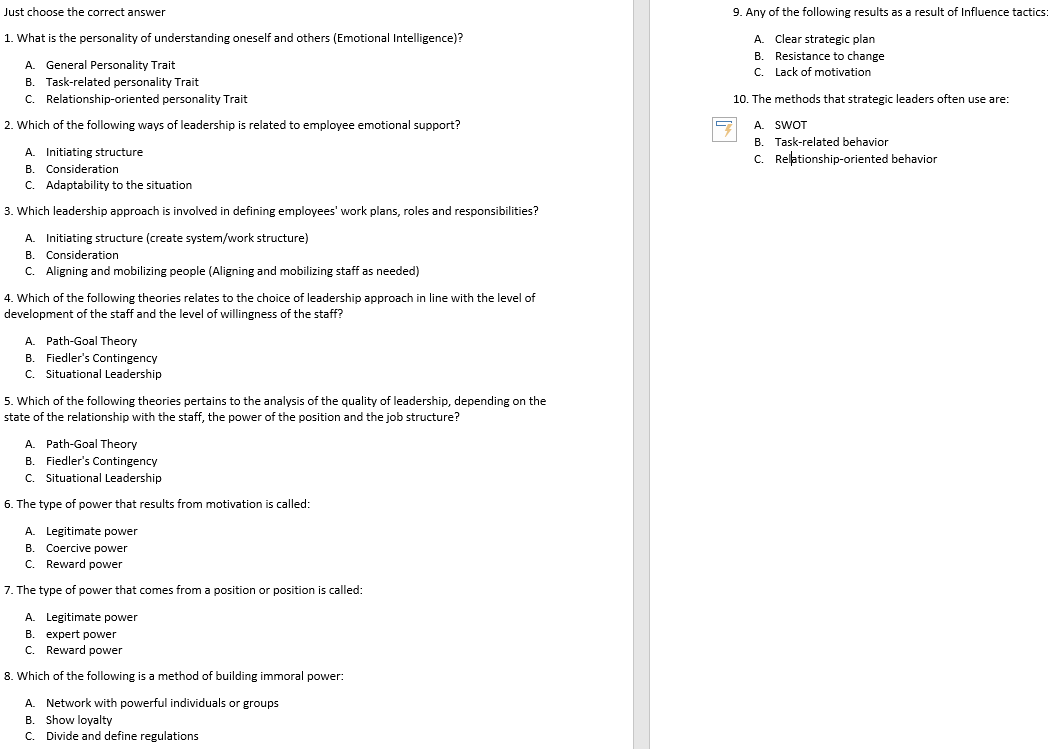Just choose the correct answer 1. What is the personality of understanding oneself and others (Emotional Intelligence)? A. General Personality Trait B. Task-related personality Trait C. Relationship-oriented personality Trait 2. Which of the following ways of leadership is related to employee emotional support? A. Initiating structure B. Consideration C. Adaptability to the situation 3. Which leadership approach is involved in defining employees' work plans, roles and responsibilities? A. Initiating structure (create system/work structure) B. Consideration C. Aligning and mobilizing people (Aligning and mobilizing staff as needed) 4. Which of the following theories relates to the choice of leadership approach in line with the level of development of the staff and the level of willingness of the staff? A. Path-Goal Theory B. Fiedler's Contingency C. Situational Leadership
Just choose the correct answer 1. What is the personality of understanding oneself and others (Emotional Intelligence)? A. General Personality Trait B. Task-related personality Trait C. Relationship-oriented personality Trait 2. Which of the following ways of leadership is related to employee emotional support? A. Initiating structure B. Consideration C. Adaptability to the situation 3. Which leadership approach is involved in defining employees' work plans, roles and responsibilities? A. Initiating structure (create system/work structure) B. Consideration C. Aligning and mobilizing people (Aligning and mobilizing staff as needed) 4. Which of the following theories relates to the choice of leadership approach in line with the level of development of the staff and the level of willingness of the staff? A. Path-Goal Theory B. Fiedler's Contingency C. Situational Leadership
Management, Loose-Leaf Version
13th Edition
ISBN:9781305969308
Author:Richard L. Daft
Publisher:Richard L. Daft
Chapter9: Managerial Decision Making
Section: Chapter Questions
Problem 2ED
Related questions
Question

Transcribed Image Text:Just choose the correct answer
9. Any of the following results as a result of Influence tactics:
1. What is the personality of understanding oneself and others (Emotional Intelligence)?
A. Clear strategic plan
B. Resistance to change
A. General Personality Trait
C. Lack of motivation
B. Task-related personality Trait
C. Relationship-oriented personality Trait
10. The methods that strategic leaders often use are:
A. SWOT
B. Task-related behavior
C. Relationship-oriented behavior
2. Which of the following ways of leadership is related to employee emotional support?
A. Initiating structure
B. Consideration
C. Adaptability to the situation
3. Which leadership approach is involved in defining employees' work plans, roles and responsibilities?
A. Initiating structure (create system/work structure)
B. Consideration
C. Aligning and mobilizing people (Aligning and mobilizing staff as needed)
4. Which of the following theories relates to the choice of leadership approach in line with the level of
development of the staff and the level of willingness of the staff?
A. Path-Goal Theory
B. Fiedler's Contingency
C. Situational Leadership
5. Which of the following theories pertains to the analysis of the quality of leadership, depending on the
state of the relationship with the staff, the power of the position and the job structure?
A. Path-Goal Theory
B. Fiedler's Contingency
C. Situational Leadership
6. The type of power that results from motivation is called:
A. Legitimate power
B. Coercive power
C. Reward power
7. The type of power that comes from a position or position is called:
A. Legitimate power
B. expert power
C. Reward power
8. Which of the following is a method of building immoral power:
A. Network with powerful individuals or groups
B. Show loyalty
C. Divide and define regulations
Expert Solution
This question has been solved!
Explore an expertly crafted, step-by-step solution for a thorough understanding of key concepts.
Step by step
Solved in 3 steps

Recommended textbooks for you

Management, Loose-Leaf Version
Management
ISBN:
9781305969308
Author:
Richard L. Daft
Publisher:
South-Western College Pub

Management, Loose-Leaf Version
Management
ISBN:
9781305969308
Author:
Richard L. Daft
Publisher:
South-Western College Pub